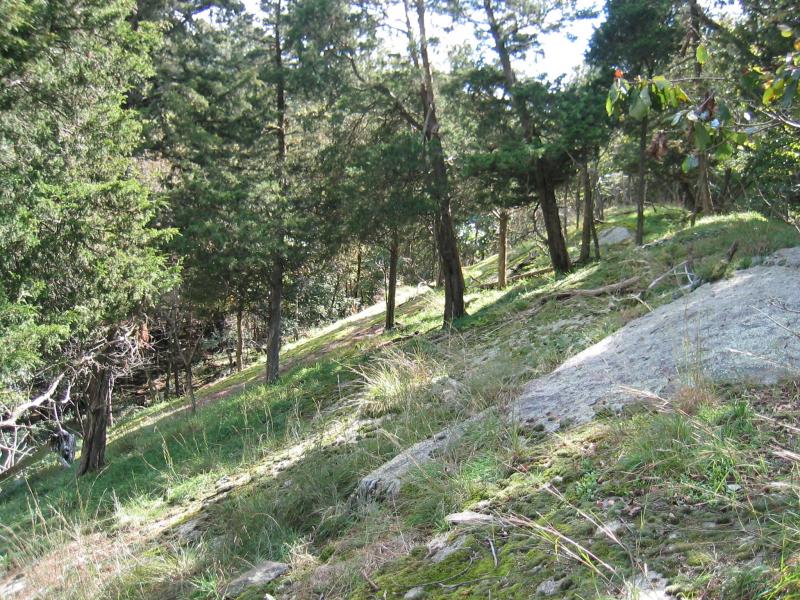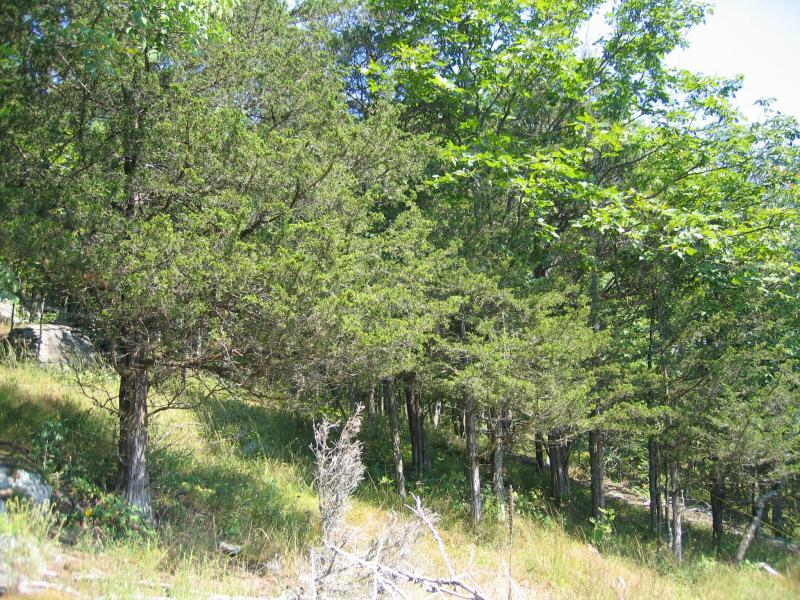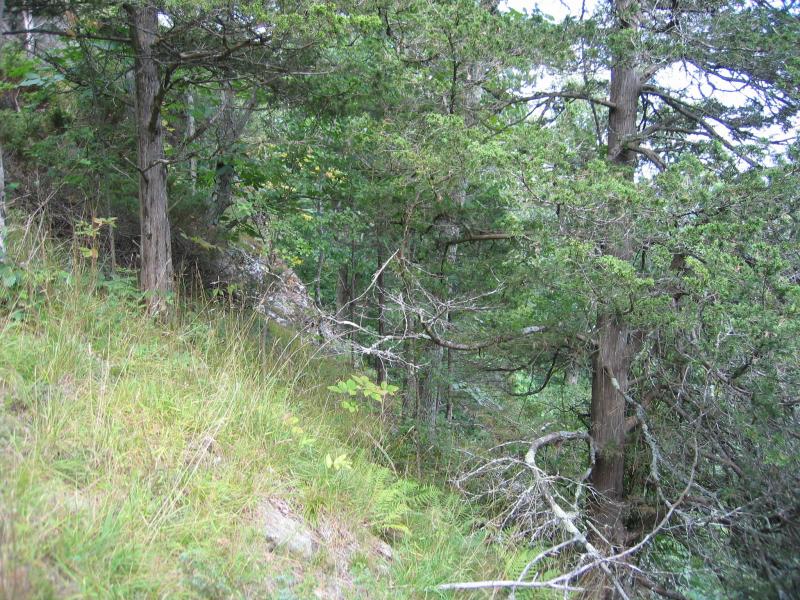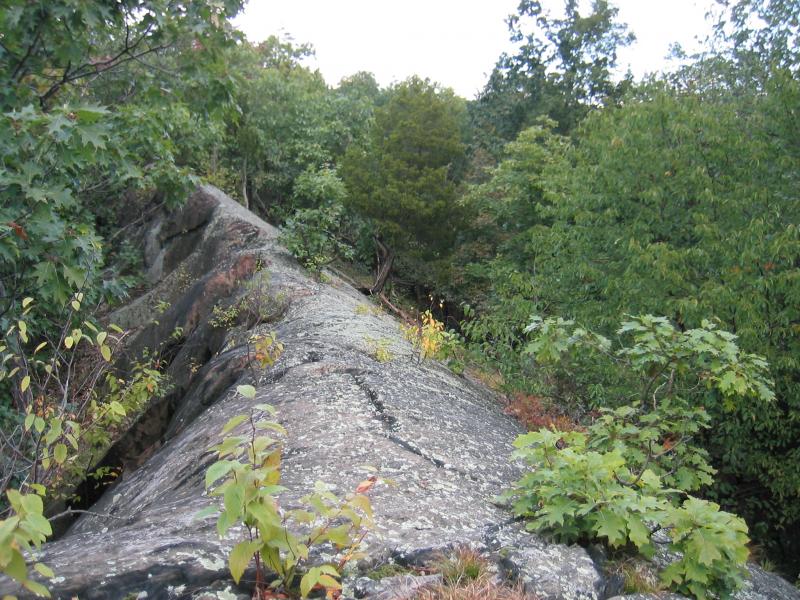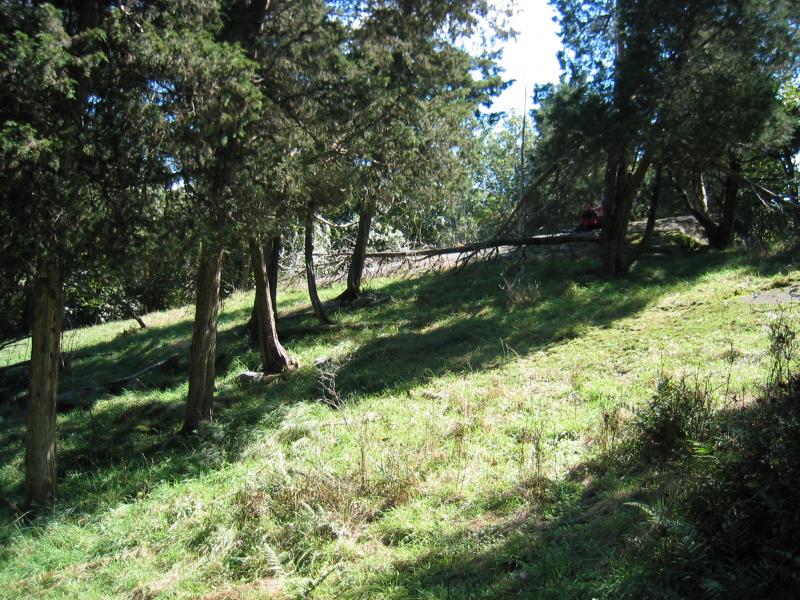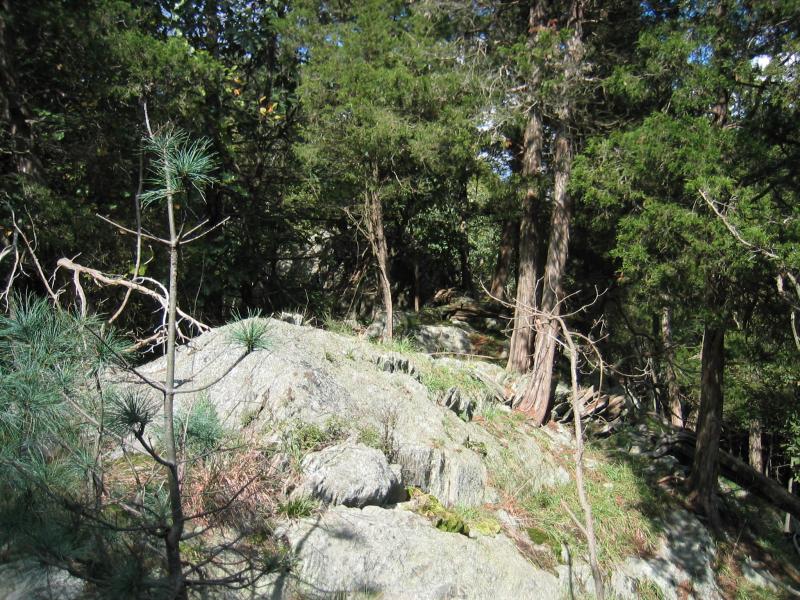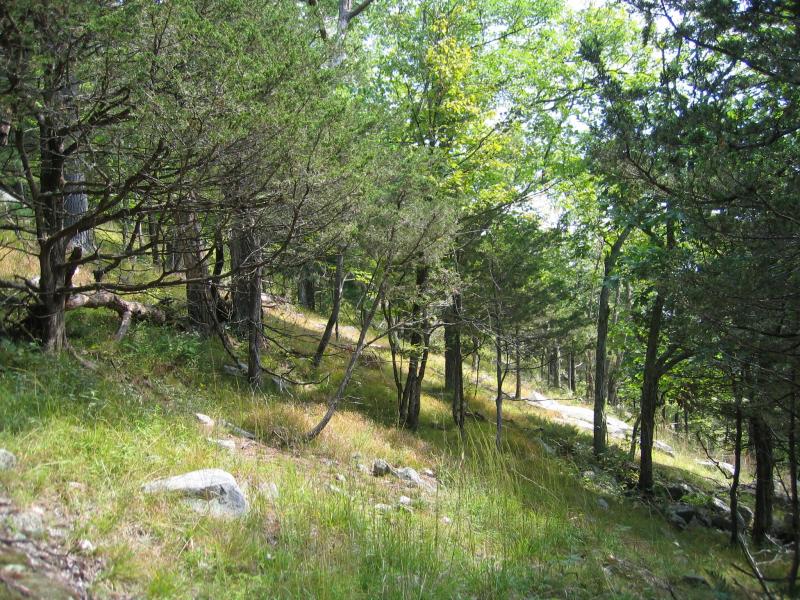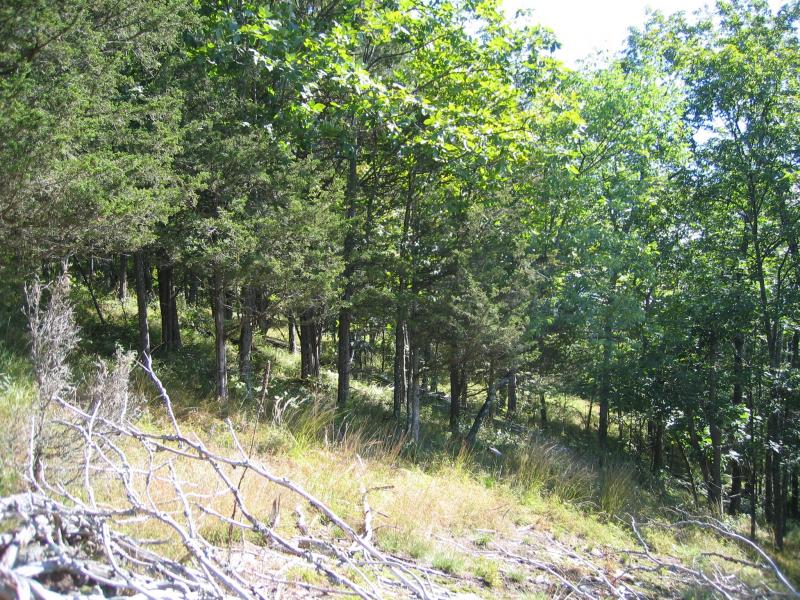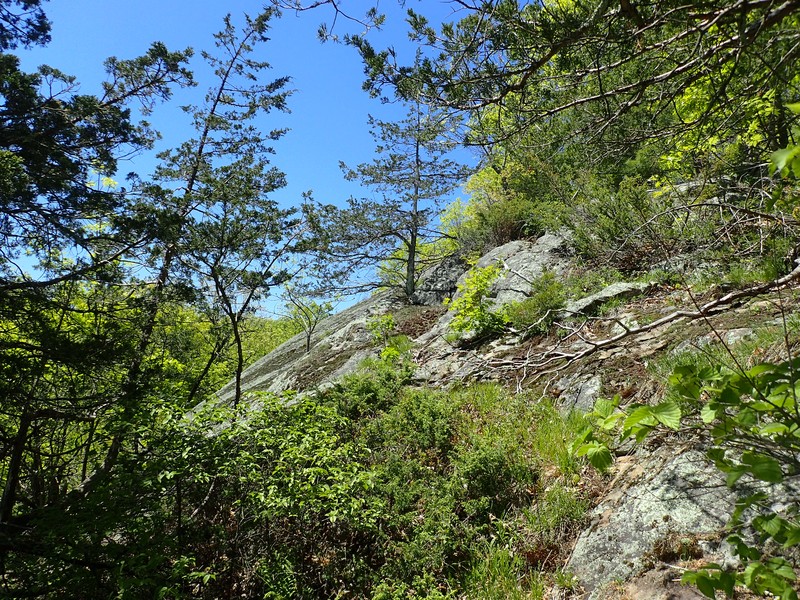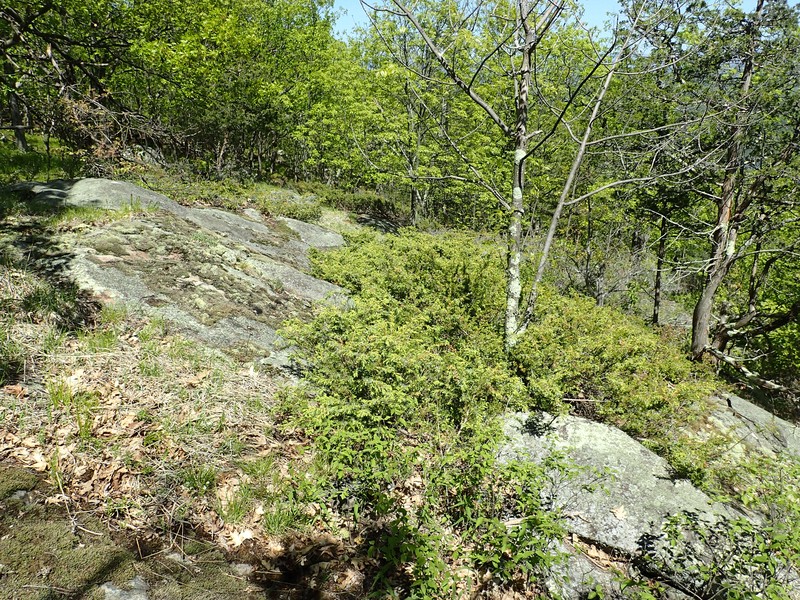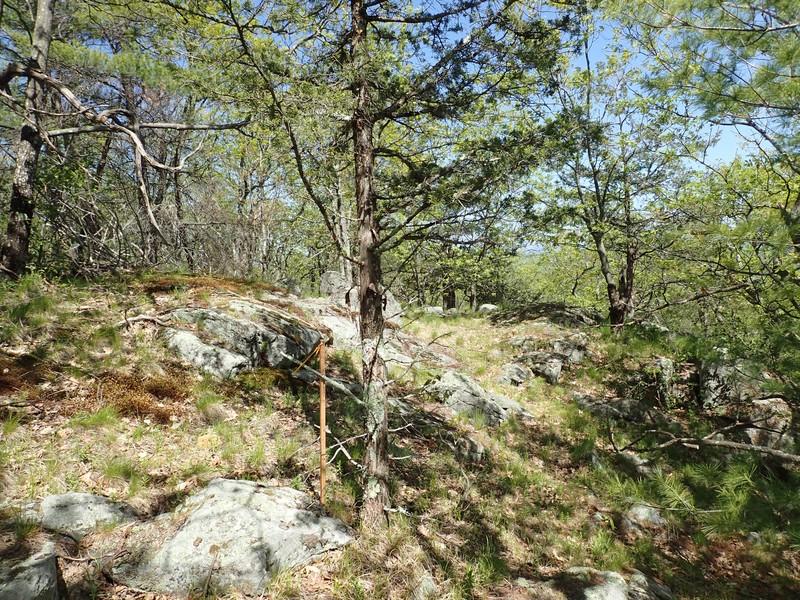Red Cedar Rocky Summit
- System
- Terrestrial
- Subsystem
- Barrens And Woodlands
- State Protection
- Not Listed
Not listed or protected by New York State.
- Federal Protection
- Not Listed
- State Conservation Status Rank
- S3
Vulnerable in New York - Vulnerable to disappearing from New York due to rarity or other factors (but not currently imperiled); typically 21 to 80 populations or locations in New York, few individuals, restricted range, few remaining acres (or miles of stream), and/or recent and widespread declines.
- Global Conservation Status Rank
- G3G4
Vulnerable globally, or Apparently Secure - At moderate risk of extinction, with relatively few populations or locations in the world, few individuals, and/or restricted range; or uncommon but not rare globally; may be rare in some parts of its range; possibly some cause for long-term concern due to declines or other factors. More information is needed to assign either G3 or G4.
Summary
Did you know?
Eastern red cedar (Juniperus virginiana) is dioecious. This means that some trees are female and some trees are male. The male trees have pollen-producing flowers and the female trees produce the familiar light blue "juniper berries." These "berries" are technically cones with fleshy blue scales and a white waxy cover, giving the them an overall sky-blue color. They are a favorite food of cedar waxwings and other birds, which disperse the seeds to other locations.
State Ranking Justification
There are several hundred occurrences statewide. A few documented occurrences have good viability and several are protected on public land or private conservation land. This community has a somewhat limited statewide distribution (correlated to circumnuetral to high pH bedrock geology). Most examples are relatively small and disturbed. This community has probably declined substantially from historical numbers and nearly all of the currently documented occurrences contain invasive plants and are threatened by fire suppression.
Short-term Trends
The number and acreage of red cedar rocky summits in New York have probably declined slightly in recent decades due to fire suppression, antenna tower construction, recreational disturbances, and invasive species.
Long-term Trends
The number and acreage of red cedar rocky summits in New York have probably declined moderately from historical numbers as a result of fire suppression, summit clearing for development, and mining of mineral resources.
Conservation and Management
Threats
Red cedar rocky summits are threatened by development (especially plans for cellular telephone and radio towers, wind farms, and similar structures) and trampling by recreational visitors (e.g., hikers). Given the stunted and gnarly growth form of summit trees, the community is only minimally threatened for timber resources. Summits on unprotected land may targeted for mining of mineral resources. Natural fire regimes (e.g., fires started through lightning strikes) may be suppressed in some areas. Clearing in the adjacent forest may be a threat that provides corridors for invasive plants. Invasive plants are a threat at several red cedar rocky summits.
Conservation Strategies and Management Practices
Management activities should include the development and implementation of prescribed burn plans at appropriate sites. Fragmenting features such as roads, abandoned tower clearings, and unnecessary trails should be reduced or minimized, and high-impact activities such as mountain biking and hang-gliding should be restricted to trails and least sensitive areas. Prevent the dumping of trash and off-trail trampling at heavily visited summits.
Development and Mitigation Considerations
Soils are very thin within and around this community, and the effect of clearing and construction on soil retention and erosion must be considered prior to any development activities. The open structure of this community is maintained by fire and presents a fire hazard to existing and proposed development. Unprotected structures located within or near this community are more susceptible to damage from fire.
Inventory Needs
Survey for occurrences statewide to advance documentation and classification of red cedar rocky summits. A statewide review of red cedar rocky summits is desirable. Continue searching for large sites in good condition (A- to AB-ranked).
Research Needs
Research the composition of red cedar rocky summits statewide in order to characterize variations and to clearly separate this community from calcareous red cedar barrens successional red cedar woodland. Collect sufficient plot data to support the recognition of several distinct red cedar rocky summits based on geology and ecoregions (e.g., limestone vs. non-limestone types, Adirondacks vs. Hudson Valley).
Rare Species
- Asclepias purpurascens (Purple Milkweed) (guide)
- Asclepias viridiflora (Green Milkweed) (guide)
- Bouteloua curtipendula var. curtipendula (Side Oats Grama) (guide)
- Carex cumulata (Clustered Sedge) (guide)
- Carex mesochorea (Midland Sedge) (guide)
- Carex retroflexa (Reflexed Sedge) (guide)
- Chamaelirium luteum (Fairywand) (guide)
- Chenopodium foggii (Fogg's Goosefoot) (guide)
- Corydalis aurea (Golden Corydalis) (guide)
- Crotalus horridus (Timber Rattlesnake) (guide)
- Draba arabisans (Rock Whitlow Grass) (guide)
- Draba glabella (Smooth Whitlow Grass) (guide)
- Falco peregrinus (Peregrine Falcon) (guide)
- Hedeoma hispida (Rough Pennyroyal) (guide)
- Houstonia purpurea var. calycosa (Midwestern Purple Bluets) (guide)
- Lechea tenuifolia (Narrow-leaved Pinweed) (guide)
- Liatris scariosa var. novae-angliae (Northern Blazing Star) (guide)
- Linum sulcatum (Grooved Yellow Flax) (guide)
- Liparis liliifolia (Lily-leaved Twayblade) (guide)
- Malaxis bayardii (Bayard's Adder's Mouth Orchid) (guide)
- Myotis leibii (Eastern Small-footed Myotis) (guide)
- Myotis septentrionalis (Northern Long-eared Bat) (guide)
- Neotoma magister (Allegheny Woodrat) (guide)
- Oxalis violacea (Violet Wood Sorrel) (guide)
- Polygonum douglasii (Douglas' Knotweed) (guide)
- Pycnanthemum torreyi (Torrey's Mountain Mint) (guide)
- Scaphiopus holbrookii (Eastern Spadefoot) (guide)
- Solidago rigida var. rigida (Stiff Flat-topped Goldenrod) (guide)
- Ulmus thomasii (Rock Elm) (guide)
Range
New York State Distribution
This community is scattered but widespread throughout upstate New York, north of the North Atlantic Coast Ecoregion, where the bedrock is circumneutral to calcareous. More common in the southern and eastern parts of this range. Probably represented by different regional variants. Concentrated in the Lower New England Ecoregion and peripheral at the southeast and eastern fringe of the Northern Appalachian Ecoregion and the Adirondack Mountains. Probably sparse in the western part of the state and likely absent from the Great Lakes Ecoregion.
Global Distribution
The range of this community is suspected to span northeast to southern Maine, west to Ohio and Kentucky, south to Tennessee, and southeast to New Jersey.
Best Places to See
- Goose Pond Mountain State Park (Orange County)
- Lake George Wild Forest, Adirondack Park (Warren, Washington Counties)
- Nellie Hill Preserve
Identification Comments
General Description
A community that occurs on warm, dry, rocky ridgetops and summits where the bedrock is calcareous (such as limestone or dolomite, but also marble, amphibolite, and calcsilicate rock), and the soils are more or less calcareous. The vegetation may be sparse or patchy, with numerous lichen-covered rock outcrops. This community is often surrounded by Appalachian oak-hickory forest. Eastern red cedar (Juniperus virginiana) is a characteristic tree. In many examples, dead or dying red cedars may be evident, which is often associated with the severe heat stress characteristic of this community (Edinger et al. 2014).
Characters Most Useful for Identification
Red cedar rocky summits are characterized by a sparse to moderate woodland located on a rocky outcrop, ridge, or summit, featuring canopy species such as eastern red cedar, red oak (Quercus rubra), shagbark hickory (Carya ovata), white ash (Fraxinus americana), eastern hop hornbeam (Ostrya virginiana), and serviceberry (Amelanchier spp). A large variety of shrub and herbaceous species may comprise the understory, including lowbush blueberry (Vaccinium pallidum, V. angustifolium), scrub oak (Quercus ilicifolia), downy arrowood (Viburnum rafinesquianum), little bluestem (Schizachyrium scoparium), tufted hairgrass (Deschampsia flexuosa), rockcresses (Arabis spp.), and maidenhair spleenwort (Asplenium trichomanes). Characteristic nonvascular species include lichens such as Cladonia spp., and bryophytes such as Polytrichum spp.
Elevation Range
Known examples of this community have been found at elevations between 40 feet and 1,600 feet.
Best Time to See
During mid to late summer, the herbaceous layer of this community, which is often diverse, comes into seasonal maturity. Ferns, sedges, asters, and other herbs that are adapted for growth on thin soils and exposed bedrock can be observed at this time. Throughout the year whenever snow is absent, an array of lichens can be observed.
Red Cedar Rocky Summit Images
Classification
International Vegetation Classification Associations
This New York natural community encompasses all or part of the concept of the following International Vegetation Classification (IVC) natural community associations. These are often described at finer resolution than New York's natural communities. The IVC is developed and maintained by NatureServe.
- Eastern Red-cedar - White Ash / Poverty Oatgrass Woodland (CEGL006002)
- Eastern Red-cedar - Hophornbeam / Bristleleaf Sedge Woodland (CEGL006180)
NatureServe Ecological Systems
This New York natural community falls into the following ecological system(s). Ecological systems are often described at a coarser resolution than New York's natural communities and tend to represent clusters of associations found in similar environments. The ecological systems project is developed and maintained by NatureServe.
- Central Appalachian Alkaline Glade and Woodland (CES202.602)
- Central Appalachian Pine-Oak Rocky Woodland (CES202.600)
Characteristic Species
-
Trees > 5m
- Carya glabra (pignut hickory)
- Carya ovata
- Fraxinus americana (white ash)
- Juniperus virginiana var. virginiana (eastern red cedar)
- Ostrya virginiana (hop hornbeam, ironwood)
- Quercus montana (chestnut oak)
- Quercus rubra (northern red oak)
-
Shrubs 2 - 5m
- Viburnum rafinesqueanum (downy arrowwood)
-
Shrubs < 2m
- Rhus aromatica var. aromatica (fragrant sumac)
-
Herbs
- Antennaria plantaginifolia (plantain-leaved pussy-toes)
- Arabis spp.
- Asplenium trichomanes ssp. trichomanes (maidenhair spleenwort)
- Avenella flexuosa (common hair grass)
- Carex pensylvanica (Pennsylvania sedge)
- Danthonia spicata (poverty grass)
- Dryopteris marginalis (marginal wood fern)
- Schizachyrium scoparium var. scoparium (little bluestem)
-
Nonvascular plants
- Cladonia furcata
- Polytrichum spp.
Similar Ecological Communities
- Calcareous cliff community
(guide)
Red cedar rocky summits and calcareous cliff communities can occur together in the landscape on the same calcareous or circumneutral bedrock outcrop. Red cedar (Juniperus virginiana) may occur in both communities. However, calcareous cliff communities are steeper (>45 degrees slope to vertical) and the vegetation is usually sparse (<10% cover), whereas red cedar rocky summits are less steep (<45 degrees slope) and the vegetation is more patchy (>25% cover).
- Calcareous talus slope woodland
(guide)
Red cedar rocky summits occur on stable consolidated rock outcrops, usually along ridges and summits, while calcareous talus slope woodlands occur on more unstable talus (loose rock) slopes. Trees are often stunted and contorted in summit communities.
- Limestone woodland
(guide)
Limestone woodlands have a greater percent cover of other conifers (northern white cedar, white pine, white spruce, balsam fir) or hardwood species (eastern hop hornbeam, sugar maple, shagbark hickory, white oak) than red cedar.
- Northern white cedar rocky summit
(guide)
While both communities may occur on calcareous or circumneutral bedrock, red cedar rocky summits are dominated by eastern red cedar (Juniperus virginiana), while northern white cedar rocky summits are dominated by northern white cedar (Thuja occidentalis).
- Rocky summit grassland
(guide)
Red cedar, and other trees and shrubs are sparse in a rocky summit grassland. Red cedar rocky summits will have more than 5% (and typically more than 25%) eastern red cedar cover.
Vegetation
Percent cover
This figure helps visualize the structure and "look" or "feel" of a typical Red Cedar Rocky Summit. Each bar represents the amount of "coverage" for all the species growing at that height. Because layers overlap (shrubs may grow under trees, for example), the shaded regions can add up to more than 100%.
Additional Resources
References
Edinger, G. J., D. J. Evans, S. Gebauer, T. G. Howard, D. M. Hunt, and A. M. Olivero (editors). 2014. Ecological Communities of New York State. Second Edition. A revised and expanded edition of Carol Reschke’s Ecological Communities of New York State. New York Natural Heritage Program, New York State Department of Environmental Conservation, Albany, NY. https://www.nynhp.org/ecological-communities/
Edinger, Gregory J. 2003. Nellie Hill: A calcareous red cedar barrens. Assessment and classification of the red cedar communities at Nellie Hill, Dutchess County, NY. A report prepared for the Eastern New York Chapter of The Nature Conservancy. New York Natural Heritage Program, New York State Department of Environmental Conservation. Albany, NY. 40 pp. plus appendices.
Edinger, Gregory J., D.J. Evans, Shane Gebauer, Timothy G. Howard, David M. Hunt, and Adele M. Olivero (editors). 2002. Ecological Communities of New York State. Second Edition. A revised and expanded edition of Carol Reschke's Ecological Communities of New York State. (Draft for review). New York Natural Heritage Program, New York State Department of Environmental Conservation. Albany, NY. 136 pp.
New York Natural Heritage Program. 2024. New York Natural Heritage Program Databases. Albany, NY.
Reschke, Carol. 1990. Ecological communities of New York State. New York Natural Heritage Program, New York State Department of Environmental Conservation. Latham, NY. 96 pp. plus xi.
Links
About This Guide
Information for this guide was last updated on: May 16, 2024
Please cite this page as:
New York Natural Heritage Program. 2024.
Online Conservation Guide for
Red cedar rocky summit.
Available from: https://guides.nynhp.org/red-cedar-rocky-summit/.
Accessed July 27, 2024.
